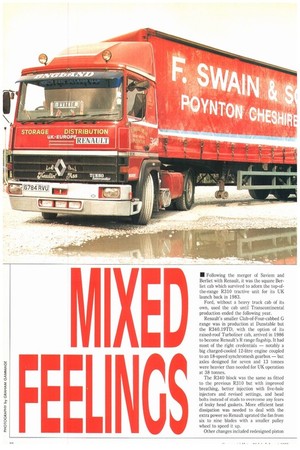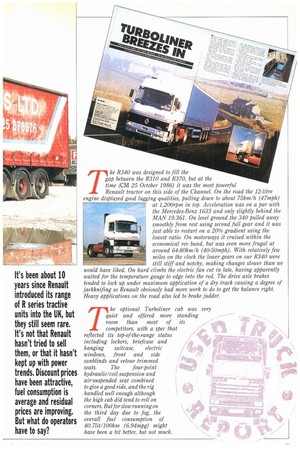F I N
Page 24

Page 25

If you've noticed an error in this article please click here to report it so we can fix it.
• Following the merger of Saviem and Berliet with Renault, it was the square BerLiet cab which survived to adorn the top-ofthe-range R310 tractive unit for its UK launch back in 1983.
Ford, without a heavy truck cab of its own, used the cab until Transcontinental production ended the following year.
Renault's smaller Club-of-Four-cabbed G range was in production at Dunstable but the R340.19TD, with the option of its raised-roof Turboliner cab, arrived in 1986 to become Renault's R range flagship. It had most of the right credentials — notably a big charged-cooled 12-litre engine coupled to an 18-speed synchromesh gearbox — but axles designed for seven and 13 tonnes were heavier than needed for UK operation at 38 tonnes.
The R340 block was the same as fitted to the previous R310 but with improved breathing, better injection with five-hole injectors and revised settings, and head bolts instead of studs to overcome any fears of leaky head gaskets. More efficient heat dissipation was needed to deal with the extra power so Renault uprated the fan from six to nine blades with a smaller pulley wheel to speed it up.
Other changes included redesigned piston
The R340 was designed to fill the gap between the R3I0 and R370, but at the time (CM 25 October 1986) it was the most powerful Renault tractor on this side of the Channel. On the road the 12-litre engine displayed good lugging qualities, Pulling down to about 75km/h (47mph) 7 -Numw' at 1,20Orpm in top. Acceleration Was on a par with the Mercedes-Benz 1633 and only slightly behind the MAN 19.361. On level ground the 340 Pulled away smoothly from rest using second full gear and it was just able to restart on a 20% gradient using the lowest ratio. On motorways it cruised within the economical rev band, but was even more frugal at around 64-80km/h (40-50mph). With relatively few miles on the clock the lower gears on our R340 were still stiff and notchy, making changes slower than we would have liked. On hard climbs the electric fan cut in late, having apparently waited for the temperature gauge to edge into the red. The drive axle brakes tended to lock up under maximum application of a dry track causing a degree of jackknifing so Renault obviously had more work to do to get the balance right. Heavy applications on the road also led to brake judder.
The optional Turboliner cab was very
quiet and offered more standing room than most of its competitors, with a spec that reflected its top-of-the-range status including lockers, briefcase and hanging suitcase, electric windows, front and side sunblinds and velour trimmed seats. The four-point hydraulic/coil suspension and air-suspended seat combined to give a good ride, and the rig • handled well enough although the high cab did tend to roll on corners. But for slow running on the third day due to fog, the overall fuel consumption of 40.7lit/100km (6.94mpg) might have been a bit better, but not much.












































































